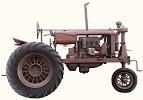


 |
 |  |
Drip irrigation would allow vegeteables to be grown in all 50 states instead of just California. With modern storage and freezing techniques, a long growing season is not usually needed. Most soils are superior to California soil being a harder clay, while freezing of the ground during the winter greatly improves soil quality and nutrients. A hundred and fifty years ago, light soils were desired, so horses didn't need to pull so hard. With 100 or more equivalent horses under the hood, soils can be a lot harder. Similarly, light soils absorb moisture faster, which facilitates irrigation. With drip irrigation, hard soil absorbs moisture just fine. But drip irrigation has not been developed for northern areas where the ground freezes. New technology is needed for that purpose. Hard clay is vastly superior to light soil (which generally means a lot of sand), because capillary action correlates with hardness. Fine texture creates hardness of soil, and it speeds up capillary action. The importance of increased capillary action is that it moves water and nutrients toward the roots instead of requiring the roots to grow toward the water and nutrients. Growth is greatly speeded up and strengthened. Freezing of the ground is extremely valuable in providing organic nutrients to plants. Most cells in the ground are broken open by ice crystals, which includes most bacteria, fungi and plant roots. The resulting cell debris is broken down by bacteria, typically Pseudomonas fluorescens, in the early spring and then released to the plants, as the bacteria self-destruct (autolyze) as a method of recycling nutrients. The result is that plants get whole molecules of amino acids and nucleosides as nutrients, which speeds up growth and frees up metabolic machinery for producing flavor and quality. Technology The most practical way to produce drip irrigation in northern areas would be to make small holes in plastic pipes, which would allow the pipes to be picked up in the fall. The holes will have to be very small to allow some pressure and still produce small amounts of dripping. Not being familiar with fluid dynamics, my guess is that the holes would have to be about 50 microns in diameter. There is no technology that will make 50 micron holes in plastic pipe. What is needed is a plasma cutter. Such cutters are used for cutting straight lines with the narrowest cuts being around 100 microns. So improvements in a plasma cutter are needed. A laser cutter will not suffice, because the plastic is quite thick, and a large amount of material needs to be pushed away as it melts. Some mass is needed to create the force. Laser waves have no mass, they just heat. Plasma is a moving mass which can push melted plastic. Moving the melted plastic through relatively thick material will require more than one cut. Probably three, maybe five, cuts will be needed, each increasing in diameter. Some developmental research is needed to get that to happen.
|
||||||||||||||||
 |
 |
 |